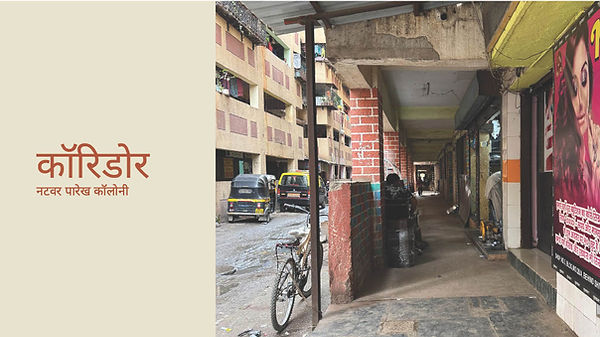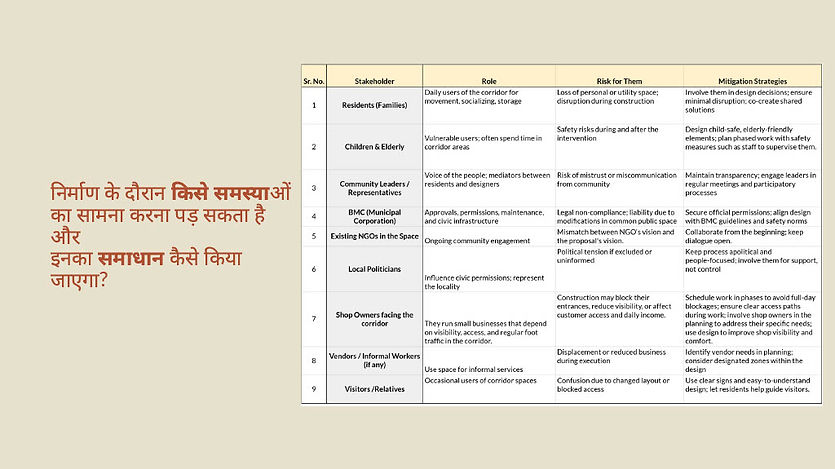Building change - Allied studies
.png)

नटवर पारेख कॉलनी ,


Allied course is a part of pedagogy in school , for exploring other things than architecture, this is work of building change course so we have been to Natwar Parekh Colony in Gavondi , Mumbai . which was rehabilation project of people who lived on footh path . for this course we were divided in 5 groups . the aim was to present to the community cosidering them as a stakeholder . what context will emerge from community? rethinking of their own place how could it be developed further.
so we were given certain exercises
1. what does inclusion meant to you ?
2. journey mapping
3. proposal for community
story of Natwar Parekh Colony
while visiting Natwar Parekh Colony, we met Parveen Ji, a social worker and community member who has spent over twenty years standing up for the rights of slum and pavement dwellers, especially women from marginalised communities. In her calm but firm voice, she began to share her journey, not just of moving into a building, but of losing something far more precious along the way. After years of living on the footpath, she had fought tirelessly for makeing community ,formal housing, organising people, fought with government officers, and keeping hope alive . When the house allotments finally came but after 2 year of finishing the construction but. What awaited them at Natwar Parekh was a colony full of garbage and broken promises. Construction debris was never cleared because the Natwar Parekh colony is situated beside Asia's largest dumping ground and the flats were allotted through a random lottery that tore old neighbours apart. People who had once cooked together, cried together, and survived together on the footpath were now scattered across different buildings and floors. The lifts did not work because parts had been stolen. Climbing up and down seven floors every day became exhausting, especially for the elderly and for mothers carrying children. Slowly, people stopped visiting each other. The flats themselves were dark and suffocating, no ventilation, no sunlight, just a constant sense of being trapped. Children had no space to play. Girl children were often kept indoors. she confidently called the colony as 'seven floor jhopda' and 'house of murdabad '
is mumbai really a posh city?
what i think is ,People often think of Mumbai as a posh city filled with high-rises, luxury apartments, and a fast-paced lifestyle. While that image is not entirely wrong, it represents only one side of the city. What many overlook is the other reality of Mumbai the vast network of slums in between the high rise and ungated communities that coexist with the city’s modern skyline. The contrast between towering glass buildings and dense informal settlements highlights the city’s deep social and economic inequalities, yet and these slum dwellers serve us they produce , recycle the waste and still they spent their life in slums.

my response to first exercise was,

the second exercise was journey mapping , it was a group exercise and it really set a inclusivity among my group , so we had a long conversation of 2 hour to know everybody in group it was a very a fun exercise ,we found some likes ,dislikes ,similarities ,difference so many shared experience among ourselves . it really helped in co-ordinating the group cause we were already comfortable after the talk.

this was the produced work ,we found some lengths such as mumbaikar vs non- mumbaikar , joint family vs nuclear analysed our journeys
third exercise was the proposal to community whom we were presenting to... we engaged the community member parvin ji to get the check of approval ..On the final day, we presented our proposal to Parvin ji, a respected community member wether, were we able to communicate and convince them of our design intent.? That interaction tested our ability to translate architectural ideas into accessible language so we used hindi in our proposal as it was easy to understand to the community .

















i explored key aspects such as budgeting, scheduling, and planning a structure. I also gained experience in presenting our ideas to the community and, most importantly, learning to think from the community’s point of view, understanding their daily social challenges and how these are tied to the use of space. here architects role is not just as a designer of buildings, but as a responsible mediator between people, place, and the environment.